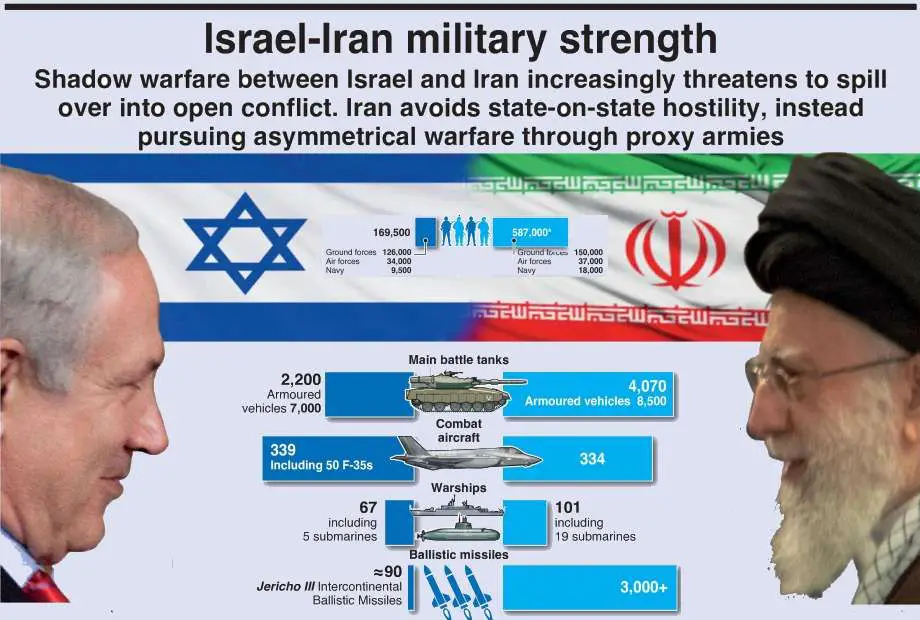The shadow warfare between Israel and Iran increasingly threatens to escalate into open conflict. Iran avoids direct state-on-state conflict, preferring asymmetrical warfare via proxy armies. Despite lacking a common border, both nations have missile, aerial, and naval capabilities that could inflict significant damage if tensions escalate. Let's examine the current military strengths of these two regional powers and assess who might prevail in an actual confrontation.
Follow Army Recognition on Google News at this link

Illustration of military strength based on GraphicNews Data (Picture source Army Recognition )
On Saturday, April 14, 2024, Iran launched a historic first direct attack on Israel, consisting of drones, cruise missiles, ballistic missiles, and, according to some sources, hypersonic missiles. This attack was almost entirely intercepted by Israeli defense systems, as well as by both longstanding allies (such as the United States, the United Kingdom, and France) and situational allies like Jordan and Syria. Since this date tension rising and war drums seem to be back.
According to the London-based International Institute for Strategic Studies (IISS), the Iranian Armed Forces are the largest in the Middle East in terms of personnel numbers, with 587,000 active members and 200,000 reservists. In contrast, Israel has 169,500 active personnel and 465,000 reservists, approximately two-thirds of whom have been deployed near the Gaza Strip since the Hamas attacks of October 7.
Unlike Israel, which has 7,000 armored vehicles of local origin, Iran possesses about 2,000 combat tanks from various technologies and nationalities. This includes around 500 T-72s, 150 American M60 tanks, and a few dozen British Chieftain tanks. Similarly, for Armored Personnel Carriers (APCs), there is a mix of different nationalities, predominantly Soviet (BTR-50) and American (M113).
The Stockholm International Peace Research Institute reports that Israel's defense budget is approximately $23.4 billion, which includes $3.18 billion in annual U.S. military aid.
Although Iran has more than 25,000 personnel, it maintains around 334 combat aircraft, including several from various origins like the F15 (U.S.) and Mig 29 (Soviet Union).
Israel, in contrast, boasts 339 combat-ready aircraft, including 309 fighter jets (F15 and F16), 50 F-35 stealth fighters, and 142 helicopters—all from the United States.
On the maritime front, both countries have a developed naval force due to their maritime borders. However, with its 101 domestically produced ships and 19 submarines experienced in operations in the Strait of Hormuz, Israel faces challenges with its 67 ships focused on coastal defense and about twenty submarines.
For anecdote, Israel conducted a covert test mission in 2018 where three F-35s flew undetected over the Iranian capital. This not only highlighted the F-35's low radar signature but also underscored Iran's unpreparedness and lack of reliable equipment. However, given the rising tensions, it's unlikely such aircraft would go undetected near the border today, reflecting Iran's heightened defensive posture compared to 2018
Pentagon officials have noted that Iran possesses over 3,000 ballistic missiles. Israel has about 90 nuclear-capable Jericho III ICBMs, though the exact number remains classified. The most recent news about Israel’s missile program came towards the end of April 2021, when several citizens captured footage of a large cloud of smoke following a reported explosion at an Israeli defense-industry facility. Some speculated that it might be Tehran’s payback for an explosion that shut down Iran’s main uranium-enrichment facility at Natanz. In fact, as Jeffrey Lewis has explained, the cloud was produced by a routine static (ground) test of a solid-rocket motor. Whether the motor is intended for an advanced Shavit or a new version of the Jericho was left to speculation: Israeli authorities will say nothing other than ‘This was a controlled test with no exceptional circumstances.’ Opacity remains the byword for Israel’s ballistic missile program.
.Iran is one of the major military forces in its region, employing a dual strategy of territorial defense and asymmetric warfare. The nation focuses on national mobilization and maintains a robust missile arsenal for defense. Additionally, Iran applies military pressure through a network of regional allies and proxies, primarily facilitated by the Quds Force of the Islamic Revolutionary Guard Corps (IRGC). This strategy includes the provision of arms to allies.
In summary, while Iran has a numerical advantage in troop numbers, this raw data should be considered in the context of diplomatic positions, longstanding and opportunistic alliances, and other factors. Currently, a proxy war involving armed militias supported by Iran and regular Israeli forces seems most likely, making a simple numerical comparison of forces less relevant.
Defense News April 2024
















